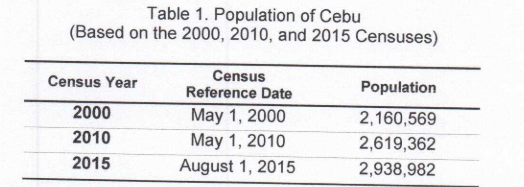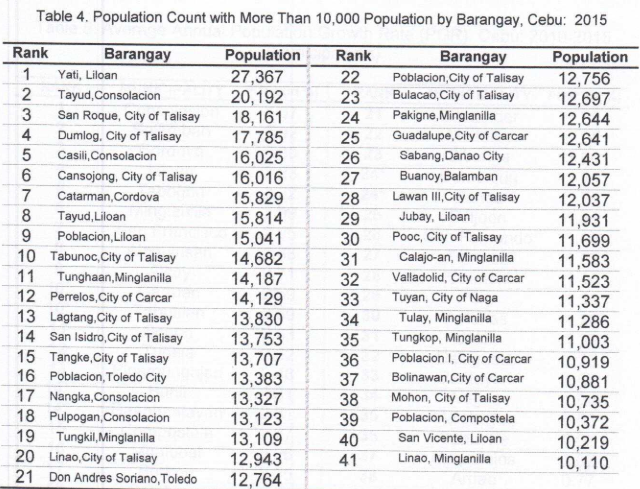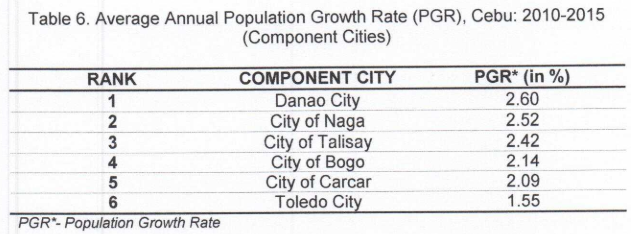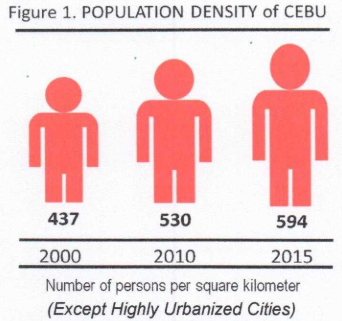Total Population of Cebu went up by 319,620 persons
As of August 2015, the population of Cebu excluding Highly Urbanized Cities: Cebu City, Lapu-Lapu City, and Mandaue City was 2,938,982 based on the 2015 Census of Population (POPCEN 2015).
The 2015 population of Cebu is higher by 319,620 compared with the population of 2,619,362 in 2010, and by 778,413 compared with the population of 2,160,569 in 2000. Refer to Table 1.

On average, the population of Cebu (except Highly Urbanized Cities) increased by 2.22 percent annually during the period 2010 to 2015. By comparison, the growth was lower during the period 2000 to 2010 at 1.94 percent annually. Refer to Table 2.

Cebu province has 6 component cities, 44 municipalities, and 1,066 barangays. Of these component cities, City of Talisay had the biggest population in 2015 with 227,645 and about 7.75 percent of the total population of Cebu (except HUCs). Among the municipalities, the municipality of Minglanilla had the biggest population with 132,135 and about 4.50 percent of the total population of Cebu (except HUCs).
City of Bogo was the smallest component city in terms of population size with 78,120 persons. The smallest municipality was Tudela with 11,296 persons and the smallest barangay with 204 persons was Kanlunsing of the municipality of Tuburan.


The fastest growing component city of Cebu province was Danao City with an average annual population growth rate (PGR) of 2.60 percent during the period 2010-2015. Consolacion also was the fastest growing municipality with an average annual population growth rate (PGR) of 4.07 percent and the fastest growing barangay with an average annual population growth rate (PGR) of 14.60 percent was barangay Suba in municipality of Samboan. Refer to Table 5 and Table 6.
Municipalities of Carmen and Tudela showed similar average annual PGR of 2.69 percent, municipalities of Barili and Daanbantayan with 2.31 percent, and municipalities of Dumanjug and Ronda with 1.75 percent respectively. Refer to Table 5.

Cebu province (except HUCs) has a total land area of 4,943.72 square kilometers, the population density in 2015 was posted at 594 persons per square kilometer. This represents an increase of 64 persons per square kilometer (12.08 percent) from the population density of 530 persons per square kilometer in 2010. In 2000, the population density was posted at 437 persons residing in every square kilometer of land.

Cordova was the most densely populated municipality, Boljoon was the most sparsely populated
Among the province’ 44 municipalities, Cordova was the most densely populated in 2015 with 3,482 persons per square kilometer of land. It was followed by Liloan with 2,586 persons per square kilometer, Minglanilla with 2,014 persons per square kilometer, Madridejos with 1,521 persons per square kilometer, and Santa Fe with 1,020 persons per square kilometer. Refer to Figure 2.
In contrast, the most sparsely populated municipality in 2015 was Boljoon with 140 persons per square kilometer of land. It was followed by Tabuelan with 182 persons per square kilometer, Oslob with 207 persons per square kilometer, Ginatilan with 227 persons per square kilometer, and Moalboal with 249 persons per square kilometer of land. Refer to Figure 3.
City of Talisay was the most densely populated Component City, City of Bogo was the most sparsely populated
Among the province’ 6 component cities, City of Talisay was the most densely populated in 2015 with 5,710 persons per square kilometer. Followed by Danao City with 1,272 persons per square kilometer. Refer to Figure 4.
The most sparsely populated component city in 2015 was City of Bogo with 755 persons per square kilometer of land.
• The POPCEN 2015 was undertaken by the Philippine Statistics Authority in August 2015 pursuant to Republic Act No. 10625, also known as the Philippine Statistical Act of 2013 and Executive Order No. 352 – Designation of Statistical Activities That Will Generate Critical Data for Decision-Making of the Government and the Private Sector, which stipulates the conduct of a mid-decade census primarily to update the population count in all barangays nationwide.
• Information on the count of the population were collected with 12:01 a.m. of August 1, 2015 as the census reference time and date.
• His Excellency President Benigno S. Aquino III declared as official for all purposes the population counts by province, city/municipality, and barangay, based on the POPCEN 2015 under Proclamation No. 1269 dated 13 May 2016. The population counts were based on census questionnaires accomplished by about 90,000 enumerators deployed during the nationwide census taking.
• The successful completion of the census-taking was made possible with the support of the local and national officials, government agencies, local government units, media, private agencies, and non-government organizations.
(SGD) FIRMO C. DIPUTADO
Chief Statistical Specialist
PSA Cebu

